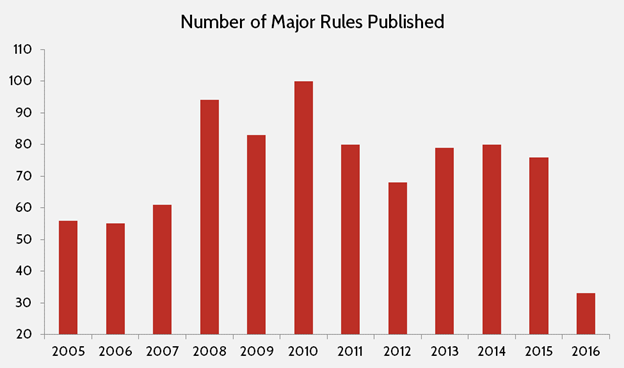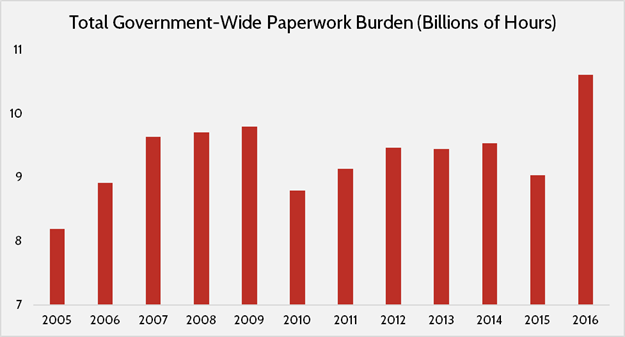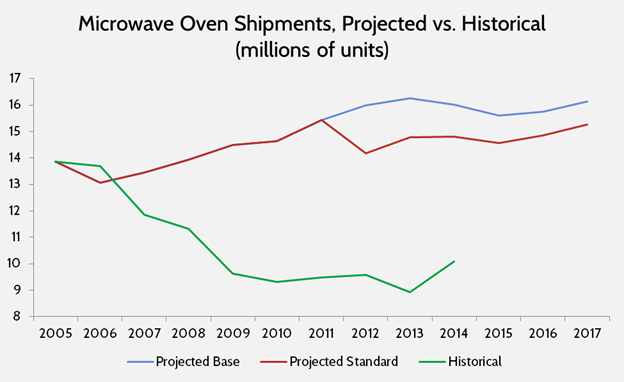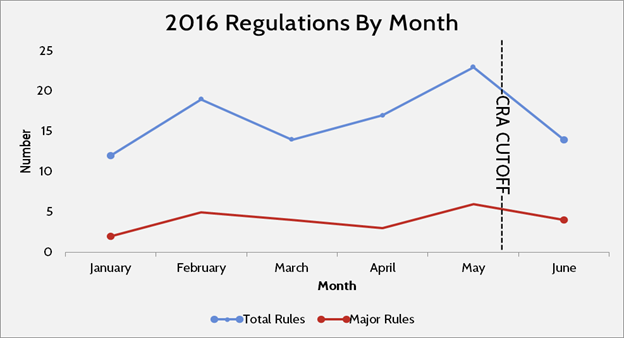Testimony
July 6, 2016
Assessing the Obama Years: OIRA and Regulatory Impacts on Jobs, Wages and Economic Recovery
- The cumulative regulatory burden of this administration is staggering by recent historical standards. During the past seven and one-half years, the Office of Information and Regulatory Affairs (OIRA) has concluded review of 453 “economically significant” rules. This figure is 38 percent more than the Bush Administration and 41 percent more than the Clinton Administration. These measures have had a profound impact on economic growth, wages, and prices for almost every consumer good imaginable.
- Under Executive Orders 13,563 and 13,610, the administration endeavored to “modify, streamline, expand, or repeal” burdensome regulations. Unfortunately, a review of the administration’s reports finds that there has been more expansion than repeal. The administration’s latest report added $16 billion in net costs and 6.5 million paperwork hours. Affordable Care Act regulations and expensive Environmental Protection Agency (EPA) measures are often categorized as “retrospective.”
- Although OIRA Administrator Howard Shelanski has pledged to curtail the “midnight” rush of regulation, the trends through the first half of 2016 reveal a surge of pre-midnight rules. Compared to similar periods during President Clinton and President Bush’s tenure, the Obama Administration has approved 38 percent more economically significant regulation than any time since 1996.
Let me provide additional detail on each in turn.
OIRA Since 2009
By virtually any metric, output at OIRA, measured by major regulation, paperwork, and costs, has been at historically high levels. This reality should not surprise Congress. The president signed two massive overhauls of the financial services and health care industries and has implemented an expansive inter-agency regulatory approach to greenhouse gas emissions. These reforms will take the shape of major regulation and they will impose costs on the economy. This reality should not be in dispute.
With that in mind, here are a few facts on regulation taken from government sources: since FY 2000, the paperwork burden has increased from 7.3 billion hours to more than 10.6 billion hours, a 45 percent increase.[1] OIRA has concluded review of 453 “economically significant” rules. This figure is 38 percent more than the Bush Administration and 41 percent more than the Clinton Administration. Currently, Americans must manage more than 20,000 government forms, mostly from the Departments of Health and Human Services, Agriculture, and Treasury.[2] In 2010, federal agencies published 100 “major” rules, more than any other year in the history of the Congressional Review Act. OIRA data make plain that FY 2012 was one of the costliest years for regulation in at least a generation.[3] See below.
The American Action Forum, in an effort to track 100 percent of federal rulemakings, has tallied the cumulative burden in every year since 2006. Looking to document the impact beyond “economically significant” rules, AAF has tracked thousands of regulations during this period. All of the figures listed below are merely data recorded directly from the Federal Register, the “Daily Journal of the United States Government.” There is no re-estimation of agency figures. If an agency states that a rule will impose $3 billion in costs, or save $3 billion, we record the data as listed each day.
From 2009 to present, the federal government has published nearly $800 billion in long-term regulatory burdens from final rules alone.[4] To put this into perspective, it’s $2,460 for every person in the U.S. During the past eight years, regulators have consistently published $100 billion in regulation and added more than 60 million paperwork burden hours each year.
What are the implications from such astronomical figures? Someone must bear the costs of regulation. Typically, it’s some combination of three parties: 1) owners of a firm through lower profits, 2) employees of a firm through lower wages or fewer jobs, and 3) consumers when these costs are passed on through higher prices. It is often thought that companies alone bear the burden of regulation, but even regulators frequently admit that cost increases are inevitable.
In previous work, the American Action Forum surveyed just 36 major regulations from the administration. Combined, these rules were estimated to increase consumer prices by more than $11,000 – everything from a more expensive car ($3,100), mortgage ($362), microwave ($14), and air conditioner ($320).[5] Annually, regulators also estimate food is at least $14 more expensive and energy $135 pricier because of rules. On the energy efficiency front, a typical consumer purchasing a new furnace fan, refrigerator, and water heater would face an additional “regulatory tax” of more than $620, according to agency calculations.[6]
Take the Department of Labor’s recent Silica rule, which will impose more than $9 billion in net present value costs. Some of the small industries affected could bear a cost-to-profit percentage exceeding 90 percent. This was considered a “significant economic impact” on small entities, but the administration predicted these expenditures would simply be passed to the consumer. They wrote, “In OSHA’s view, however, affected industries would generally be able to pass on most or all of the costs of the rule in the form of higher prices rather than bear the costs of the rule in reduced profits.”[7] This is a brutally honest assessment from regulators that ordinary Americans routinely bear the burdens of federal rules.
Strident proponents of the current regulatory environment respond by noting the estimated benefits of federal rules exceed the costs. True, federal regulations also generate billions of dollars in benefits, but for many rules, those benefits figures are suspect. For example, the 2006 efficiency standards for air conditioners predicted 3.7 million new shipments of air conditioners in 2005. Instead, the year before the standards went into effect, there was a surge in orders, nearly 5.9 million. After the standards took effect, the agency predicted a slight drop in shipments, in part because of higher prices. The projected drop was 2.1 percent; the actual decline was 26.1 percent, at a time when unemployment hovered around 4.4 to 4.8 percent. For the benefits of this rule, projected shipments have exceeded actual shipments. This suggests the agency likely overestimated the benefits of the rule.
Likewise, for another efficiency standards rule for microwaves, the actual shipments (in green) compared to projected shipments (in red and blue) demonstrate that regulatory prognostication on benefits is often subject to error.
In some competitive markets, firms won’t be able to pass costs onto consumers. Frequently, employees must pay through reduced wages or layoffs. During the Obama Administration, we have seen both. The American Action Forum’s research found that the Affordable Care Act has reduced small business pay (20 to 99 workers) by at least $22 billion annually. In addition, regulations and rising premiums have reduced small business employment by 350,000 jobs nationwide.[8]
Although not an Obama-era regulation, the 2008 ozone standards have resulted in similar effects. The American Action Forum compared non-attainment and attainment counties and found the following: non-attainment counties lost $56.5 billion in total wages, $690 per worker, and 242,000 jobs between 2008 and 2013.[9] Rather than wait until full implementation of past standards, OIRA and the administration released another round of standards last year, which will cost $1.4 billion and add more than 330,000 paperwork hours onto states and private industry.[10]
These projections might appear mundane, or extreme, depending on one’s perspective, but even regulators routinely admit that regulation can reduce employment. Based on a review of rules from 2012 to 2015, the American Action Forum found regulators have projected more than 85,700 lost jobs from regulation, or roughly the population of Asheville, NC.[11] This figure is also based on a just a fraction of overall major regulation; many agencies decline to estimate the impact of regulation on employment. However, in 2015 alone, the Department of Energy projected that its seven significant regulations could cut 8,000 manufacturing jobs.
OIRA’s perspective on the regulatory landscape is decidedly different from what has been outlined here. The agency often portrays regulatory costs as just fraction of regulatory benefits. Yet, by OIRA’s own admission, its Report to Congress omits scores of significant rulemakings from its total. By failing to quantify the ever-growing burden from independent agencies, the report often undercounts regulatory costs. The Volcker Rule alone will impose $4.3 billion in burdens, but that figure wasn’t tallied in OIRA’s FY 2014 report.[12] Furthermore, large burdens emanating from Dodd-Frank are also uncounted: Resource Extraction, Conflict Minerals, and the Volcker Rule. In 2012 and 2013 alone, independent agencies published eight rulemakings with at least $100 million in annual costs, for a total burden of more than $4 billion annually. Cabinet agency rules that fall just under the economically significant threshold are also omitted from OIRA’s main tabulation.
The original purpose of the Regulatory Right to Know Act was to provide an accounting of all regulatory costs and benefits from “Federal rules,” not just cabinet agency rules, in an effort to mirror the fiscal budget. Although the OIRA Report to Congress does provide a detailed accounting, excluding all independent agencies from its yearly tally severely skews the data. Monetizing the benefits from actions by financial regulators, who tend to be independent from the executive, might be difficult, but recent case law suggests it might soon be an imperative.
In addition, the role of OIRA and agencies in using discount rates can sometimes turn a regulation with net benefits into one with net costs. Often misunderstood or unknown by the general public, discount rates are simply an acknowledgement that costs and benefits do not take place during the same time horizon. To correct for this asymmetry, regulators discount the costs and benefits that may accrue immediately or in the distant future.
For example, using agency math for efficiency standards for refrigerators, a five percent discount rate yields modest net savings for consumers: $24. However, employing a discount rate that actually represents middle-class consumer preferences (11 percent) results in net costs of $30 for consumers.[13] For reform, Congress and OIRA should determine the best discount rate that reflects actual consumer preferences, not the figure that most easily justifies regulation.
Finally, although OIRA still struggles with transparency, its role, given the regulatory output, is more important today than ever. Under OIRA’s watch, it continually fails to follow the Regulatory Right to Know Act by submitting tardy reports to Congress on the costs and benefits of federal rules. In addition, it has failed to issue an Information Collection Budget of the U.S. for the past two years, an inexcusable delay that has never been explained.[14] There are also constant problems with agency and OIRA compliance with the Paperwork Reduction Act, the Unfunded Mandates Reform Act, and the Congressional Review Act. If there is a reason talks of regulatory reform and enhanced OIRA scrutiny are prevalent, it is because the current law is often ignored or perhaps willfully flouted.
The figures above are not meant to paint a picture that OIRA does not serve an important role. Its role in a well-functioning regulatory state is essential. Annually, its staff of around 40 review approximately 400 rulemakings to determine if rules serve the intended statutory purpose without unduly burdening the economy. Despite harsh criticism that OIRA causes unnecessary delays, the agency limits the total lifetime of major rulemakings (from first publication in the Unified Agenda to final publication in the Federal Register) to 401 days.[15] Although OIRA has approved record levels of regulation recently and has struggled with transparency, there is still plenty of room for sensible reforms of the agency.
Additive Retrospective Review
Although President Obama has issued several major executive orders outlining his vision for the regulatory state, to date there have been relatively modest efforts to “modify, streamline, expand, or repeal” burdensome regulations. Instead, the administration has implemented more regulations to expand than to repeal.[16]
Despite reform attempts, every year Democrats and Republicans bemoan the current state of regulation. President Obama continued that tradition when he issued Executive Order 13,563, demanding that the “regulatory system must protect public health, welfare, safety, and our environment while promoting economic growth, innovation, competitiveness, and job creation.” It also called on regulators to look back at existing regulations to “modify, streamline, expand, or repeal” those that were redundant or ineffective.
After more than five years of regulatory reform, it’s clear that regulators have sought to expand regulations more than modify. Retrospective review reports are filled with more new proposals designed to address current issues than regulatory reviews designed to examine whether past rules succeeded or failed. For example, energy efficiency standards are included in retrospective reports, even though they are implementing new standards. The Department of Education continues to insist the new “Gainful Employment” regulation that adds billions of dollars in costs and millions of burden hours was somehow designed to scrutinize “existing significant regulations.” It clearly was not.
Regulators either engage in an honest attempt to examine the regulatory state by looking back at past rules and measuring their costs and benefits, or they add new burdens that address current problems. Too often, it is the latter. In the most recent retrospective reports, the administration managed to add $16 billion in regulatory costs, even though the reports are ostensibly deregulatory in nature. For example, with all the problems that the Department of Veterans Affairs has had in the past, they managed to list just one specific rulemaking. By comparison, the Department of Transportation listed 43 rulemakings, planning to cut $847 million in costs and remove 21 million hours of paperwork.[17]
The cabinet-wide success of retrospective review is incredibly uneven. Typically, agencies implement new regulation under the guise of retrospective review. Take the Department of Health and Human Service’s recent inclusion of a food safety rule, implementing the Food Safety Modernization Act of 2011 (coincidentally, the same year President Obama signed his lodestar executive order on reform). The rulemaking imposes $3.3 billion in long-term costs and imposes 6.2 million paperwork burden hours.[18] It isn’t retrospective. If it is, then all new rulemakings are retrospective. How can a rulemaking be retrospective if it is implementing a new law?
New greenhouse gas standards are retrospective because they “look back” at previous regulations addressing emissions at power plants and then add new standards? Thankfully, EPA has not included these measures in its retrospective reports, but it does include its “Tier 3” rulemaking, which imposes $1.5 billion in annual burdens and its 2017 to 2025 vehicle efficiency standards, at an annual cost of $10.8 billion. Incredibly, the administration routinely includes new Affordable Care Act regulations in its retrospective reports, perhaps hoping that no one will notice. Its most recent report included a rule for “Covered Outpatient Drugs,” adding $330 million in costs and 3.1 million new paperwork hours.
On its website touting the success of retrospective review, OIRA proclaims, “review of regulations has resulted in finalized initiatives expected to achieve $20 billion in savings over five years.”[19] We have never seen an itemized list of these savings, but we suspect the final annual cost savings reach $7.2 billion, with another $420 million in proposed annual savings. By comparison, measures that increase costs that were included in these reports will add more than $18.9 billion in annual costs. Thus, on net, the regulatory burden will increase by $11.7 billion because of rulemakings contained in these supposedly “retrospective” reviews. After five years, the retrospective review effort might have earned the administration some public relations plaudits, but from a public policy perspective, it has failed.
The failure of recent retrospective review efforts masks what could have been a positive agenda for regulatory reform. All the ingredients were present for reform: a willing Congress, voters generally upset with the amount of regulation, and a President who had expressed an interest in reform. The House has passed several measures that would have more effectively addressed retrospective review than the president’s agency-led approach.
The Searching for and Cutting Regulations that are Unnecessarily Burdensome Act (SCRUB) would delegate authority to an independent commission to determine which past regulations are no longer generating significant benefits at an acceptable cost. According to past estimates from the American Action Forum, SCRUB could save more than $48 billion in costs and 1.5 billion paperwork hours.[20]
In addition, a well-designed regulatory budget is another possible tool Congress and the administration could use to address past regulation. The United Kingdom and Canada have both adopted forms of a regulatory budget, without environmental or workplace safety calamities.[21] A budget is merely the recognition that society has a finite amount of resources. We employ budgets for fiscal policy and limit taxes, but regulators are free to regulate as much as possible, absent intervention from the courts and occasionally OIRA. A budget would allow regulators to prioritize the most pressing regulations annually, while giving them credit for reforming past rules. A budget would also give Congress much needed input on the nation’s regulatory output.
Twilight and Midnight Regulation
Rushing regulation after a presidential election and before the next president takes office, defined broadly as “midnight regulation,” has plagued administrations from President Carter, to Presidents Clinton and Bush. To paint a picture of how swiftly some rules can move through the process, an economically significant rule for heat pumps was proposed in October 2000 and finalized by January 2001, a period of just 107 days.[22] There are comment periods that last longer than the entire history of that significant rulemaking.
Like his predecessors, Administrator Shelanski has issued a memo warning against a rush in federal rules this year. He urged, “Agencies should strive to complete their highest priority rulemakings by the summer of 2016 to avoid an end-of-year scramble that has the potential to lower the quality of regulations that OIRA receives for review and to tax the resources available for interagency review.”[23] President George W. Bush’s Chief of Staff made similar pleas in 2008, but the midnight regulatory rush still proceeded at a historic pace.
Congress and the public won’t know the success of Administrator Shelanski’s memo until next year. The result of the upcoming election will largely determine the speed with which the administration, OIRA, and independent agencies proceed this fall. However, the administration already has an aggressive regulatory record and pending agenda planned this year.
To date, regulators have finalized more than $87 billion in final rules, accompanied with 46 million hours of paperwork.[24] There is some evidence the rush in regulation is already in the past. Faced with the carryover provision of the Congressional Review Act (CRA), which the American Action Forum estimated initially at May 17, 2016, there were obvious incentives for the administration to finalize as many controversial regulations as possible without the fear the next Congress and administration could rescind the measures.[25]
For example, through the first five months of the year, regulators have approved 58 significant rulemakings; the next two closest outputs during presidential election years were 42 and 39 rulemakings, respectively. In April, the administration released 16 significant rules and in May it approved 14. These include final overtime standards, the Silica rule, revised food labeling standards, and a fracking measure for oil and gas wells. Below is a graphical look at total and major rulemakings, with a line denoting a probable CRA carryover date.
The graph is hardly a slam dunk in favor of the hypothesis that presidents act to finalize rules before the CRA takes effect, but there is a noticeable spike in May for total and major rules. In May of 2016, OIRA approved 14 significant rulemakings, which was more than any other May in a presidential election year since 1996. Regulators also published $22 billion in costs, compared to just $2.8 billion in costs in May of 2015. Although this data might be suggestive, it doesn’t definitively prove that the carryover provision of the CRA rushed certain decisions from the White House.
Finally, if there is a legitimate rush in regulation, where the life of major rulemakings is measured in days, instead of months and years, Congress has a policy tool to address this abuse: the CRA. Although it has been used only once successfully, the CRA allows Congress the convenience of expedited procedures to address major regulations. If there are potential rules to which a majority of Congress objects, Congress is well within its right to rescind those measures. However, if repealed, they “may not be reissued in substantially the same form,” so the CRA is a blunt policy instrument to address rules Congress finds truly objectionable. Allowing Congress to address several measures en banc would expedite the process, which the law itself seeks to do in several different ways. Regardless of the process, Congress should use its power to scrutinize rules that lack proper, or any review, and that have significant negative impacts on their constituents.
Conclusion
OIRA has played a critical role in managing the nation’s regulatory apparatus for more than a generation. Although critiques of the agency are justified, mainly on transparency grounds, its status as a gatekeeper for federal regulation is vital. Unfortunately, its output during this administration will have profound implications for the American economy. These implications may not show up in national unemployment numbers, but in the wages of hundreds of industries, and in the prices paid by millions of Americans.
OIRA should continue to stand firm against a potential rush of rules this fall and Congress should explore additional reforms to increase transparency, accountability, and curtail inefficient regulation.
[1] Office of Management and Budget, “Information Collection Budget of the United States Government 2014,” available at https://www.whitehouse.gov/sites/default/files/omb/inforeg/icb/icb_2014.pdf; http://www.reginfo.gov/public/do/PRAReport?operation=11.
[2] American Action Forum, “How Many Federal Forms are There?” available at https://www.americanactionforum.org/insight/many-federal-forms/.
[3] Office of Information and Regulatory Affairs (OIRA), “2013 Report to Congress on the Benefits and Costs of Federal Regulations and Unfunded Mandates on State, Local, and Tribal Entities,” available at https://www.whitehouse.gov/sites/default/files/omb/inforeg/2013_cb/2013_cost_benefit_report-updated.pdf.
[4] American Action Forum, “Regulation Rodeo,” available at http://bit.ly/293w2F0.
[5] American Action Forum, “The Consumer Price of Regulation,” available at http://bit.ly/29oNzbl.
[6] American Action Forum, “DOE: Under-the-Radar, Overly Burdensome,” available at http://bit.ly/295LRP1.
[7] American Action Forum, “Final OSHA Silica Standards,” available at http://bit.ly/29cbq1Q.
[8] American Action Forum, “ACA’s Impact on Small Business Wages and Employment,” available at http://bit.ly/295M7NR.
[9] American Action Forum, “County-Level Effects of EPA’s 2008 Ozone Standards on Employment and Pay,” available at http://bit.ly/29oNUec.
[10] American Action Forum, “Regulation Rodeo,” available at http://bit.ly/1UwmvqL.
[11] American Action Forum, “Regulators Admit Rules Could Eliminate 85,000 Jobs,” available at http://bit.ly/292u4DU.
[12] Office of the Comptroller of the Currency, “Analysis of 12 CFR Part 44,” available at http://www.occ.gov/topics/laws-regulations/legislation-of-interest/volcker-analysis.pdf.
[13] American Action Forum, “Discounting Consumers: How DOE’s Wishful Thinking Leads to Higher Costs, Fewer Jobs,” available at http://bit.ly/292tWEv.
[14] Office of Management and Budget, “Information Collection Budget of the United States Government,” available at http://1.usa.gov/295auZs.
[15] Regulation, “What Regulatory Ossification?” available at http://bit.ly/294PLt0.
[16] 76 Fed. Reg. 3,821, available at http://1.usa.gov/1CzWyCQ.
[17] American Action Forum, “Administration’s First 2016 ‘Regulatory Review’ Adds $16 Billion in Costs,” available at http://bit.ly/2908oIx.
[18] American Action Forum, “Regulation Rodeo,” available at http://bit.ly/1UmtdD8.
[19] Office of Management and Budget, “Retrospective Review of Regulations,” available at http://1.usa.gov/1QRqpYE.
[20] American Action Forum, “Sue and Settle Reform, SCRUB Act Could Save $48 Billion, 1.5 Billion Hours,” available at http://bit.ly/1ns1zX2.
[21] American Action Forum, “Why Critics of a Regulatory Budget Have it Wrong,” available at http://bit.ly/295hc1y.
[22] Office of Information and Regulatory Affairs, “Standards for Central Air Conditioners and Heat Pumps,” available at 1.usa.gov/1UOwQi7.
[23] Office of Information and Regulatory Affairs, “Regulatory Review at the End of the Administration,” available at 1.usa.gov/1TH9753.
[24] American Action Forum, “Regulation Rodeo,” available at http://bit.ly/1ndLMvv.
[25] American Action Forum, “May 17, 2016: Regulation Day for Obama Administration,” available at http://bit.ly/293w3c0.















August 27, 2014
Comments for the Record
AAF Comments to White House on Costs and Benefits of Regulation
Sam Batkins
Based on the American Action Forum’s (AAF) analysis of all final rules issued in FY 2013 that quantified costs (310) and benefits (18), annualized costs…